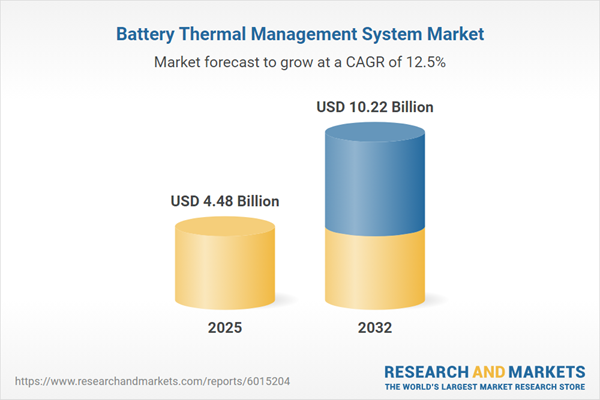Speak directly to the analyst to clarify any post sales queries you may have.
Accelerating electrification in transportation, industry, and energy storage is redefining operational requirements for battery management systems. Senior decision-makers require actionable, forward-facing insights to navigate regulatory complexity and drive sustainable, reliable growth as the battery thermal management system market evolves.
Market Snapshot: Battery Thermal Management System Market
The battery thermal management system market is showing marked growth, expanding from USD 3.98 billion in 2024 to USD 4.48 billion by 2025, and is forecast to reach USD 10.22 billion by 2032, reflecting a 12.49% compound annual growth rate (CAGR). This expansion is largely driven by increased demand from electrified vehicles across commercial, passenger, and industrial segments, alongside broader use cases in both stationary and mobile energy storage. Rising global safety standards and new regulatory expectations are encouraging organizations to implement more advanced, reliable thermal management protocols to ensure compliance and operational continuity. Companies are proactively responding to evolving customer needs, emphasizing product safety and aligning with shifting reliability benchmarks in diverse applications.
Scope & Segmentation: Battery Thermal Management System Market
- End Use Applications: Encompasses consumer electronics, commercial vehicles, passenger vehicles, stationary energy storage, mobile storage, and varied industrial equipment. Sector-specific challenges in reliability and safety are addressed through tailored management systems targeting each environment.
- Cooling Technology: Includes solutions such as air cooling, liquid cooling using dielectric oil or water glycol, and refrigerant-based methods. Each supports unique industry priorities ranging from compliance to operational efficiency.
- Battery Chemistry: Covers lead acid, lithium iron phosphate, lithium nickel cobalt aluminum oxide, lithium nickel manganese cobalt oxide, and nickel metal hydride. Selection depends on performance lifespan, safety, and regulatory compliance.
- System Type: Features active air-based, active liquid-based, and passive thermal management approaches, providing flexibility for organizations to align technology with individual performance or risk-reduction objectives.
- Regions: Examines the Americas, including the United States, Canada, Mexico, and Latin America; Europe; the Middle East and Africa; and Asia-Pacific with a focus on China, India, Japan, Australia, and Southeast Asia. Local sourcing strategies, compliance pressure, and implementation pace vary substantially across these regions, influencing adoption curves and procurement models.
- Key Companies: Highlights MAHLE GmbH, Valeo SA, Robert Bosch GmbH, Denso Corporation, Hanon Systems Co., Ltd., Modine Manufacturing Company, Marelli Corporation, Gentherm Incorporated, Vitesco Technologies GmbH, and Thermo King Corporation, with each actively shaping the market through new product development and strategic collaboration.
Key Takeaways for Decision-Makers
- The adoption of advanced battery solutions within both the mobility and grid sectors emphasizes the critical need for robust thermal management as a cornerstone of safety.
- Rising operational demands are driving organizations to design adaptable passive and active cooling strategies that are aligned with sector-specific performance and sustainability expectations.
- The integration of IoT and modular designs is facilitating real-time analytics, enabling predictive maintenance and supporting data-driven decisions across the supply chain.
- Sustainability considerations are prompting shifts in refrigerant and material selection, directly influencing supply chain and R&D focus areas across the sector.
- Enhanced supplier diversification and close collaboration are essential for navigating global trade volatility, reducing exposure to supply disruptions, and ensuring stable access to essential materials.
- Market leaders remain responsive to regulatory changes and technology cycles by embracing digitalization and strategic partnerships to reinforce adaptability and resilience.
Tariff Impact: Regulatory Drivers and Supply Chain Adaptation
Recent changes in trade tariffs affecting battery thermal management components are causing companies to reconsider sourcing and production. Approaches such as nearshoring, onshoring, and greater supplier diversification are being implemented to strengthen supply chain resilience. These strategies drive deeper collaboration with original equipment manufacturers, support targeted process improvements, and enhance risk management practices across the value chain.
Methodology & Data Sources
This analysis utilizes comprehensive secondary research from established industry datasets, complemented by direct interviews with executives, engineers, and procurement experts. Review by subject matter specialists and key stakeholders assures the insights are practical and directly relevant to decision-making needs.
Why This Report Matters
- Provides senior leaders with actionable guidance on navigating regulatory change, competitive pressure, and complex operational environments in the battery thermal management system market.
- Enables more effective strategy development by offering insights that support risk mitigation, forward-looking capital allocation, and prioritized innovation.
- Delivers sector-specific and regional intelligence to support executive-level planning, investment, and technology decision-making.
Conclusion
Executives who drive compliance, cultivate innovation, and invest in digital transformation will be strategically positioned to manage risk and capture opportunity as battery thermal management systems become foundational to next-generation electrification.
Additional Product Information:
- Purchase of this report includes 1 year online access with quarterly updates.
- This report can be updated on request. Please contact our Customer Experience team using the Ask a Question widget on our website.
Table of Contents
3. Executive Summary
4. Market Overview
7. Cumulative Impact of Artificial Intelligence 2025
Companies Mentioned
The companies profiled in this Battery Thermal Management System market report include:- MAHLE GmbH
- Valeo SA
- Robert Bosch GmbH
- Denso Corporation
- Hanon Systems Co., Ltd.
- Modine Manufacturing Company
- Marelli Corporation
- Gentherm Incorporated
- Vitesco Technologies GmbH
- Thermo King Corporation
Table Information
| Report Attribute | Details |
|---|---|
| No. of Pages | 186 |
| Published | October 2025 |
| Forecast Period | 2025 - 2032 |
| Estimated Market Value ( USD | $ 4.48 Billion |
| Forecasted Market Value ( USD | $ 10.22 Billion |
| Compound Annual Growth Rate | 12.4% |
| Regions Covered | Global |
| No. of Companies Mentioned | 11 |









